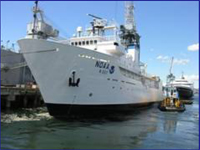2008 Key Accomplishments
NOAA Research studies the Earth system from the depths of the ocean to the upper reaches of the atmosphere. Our world-class scientists conduct preeminent research that contributes to public health and safety, healthy ecosystems, and a robust economy. This requires transfer of research to operations, as well as continued exploration and discovery in new areas that will expand the boundaries of our understanding of the Earth system and lay the foundation for future NOAA services.
NOAA Deploys 3000th Argo Float

NOAA researchers, including those at NOAA's Joint Institute for Marine Observations, met the goal of deploying and maintaining 3,000 Argo floats in active service. The Argo array of profiling floats provides essential broad-scale, basin-wide monitoring of upper ocean heat content. The Argo network allows scientists to gather real-time, evolving data around the clock and around the world. Some climate scientists have posited, though lack data to verify, that the ocean has absorbed more than 80 percent of excess heat generated by climate change over the past 50 years. With a complete Argo network, scientists can test such hypotheses and advance study of the ocean's role in climate variability.
NOAA Completes Climate Reference Network
NOAA's Air Resources Laboratory finished installing the 114 stations composing the U.S. Climate Reference Network (CRN) to track national average changes in temperature and precipitation trends with exceptional precision. The CRN, funded through OAR's Climate Program Office, will help pinpoint shifts in America's changing climate. All stations are constructed in rural environments, away from urban areas that could confound interpretation of observed trends. Each CRN station logs real-time measurements of surface temperature, precipitation, wind speed, and solar radiation. NOAA exceeded its goal of improving the percentage of explained variance in temperature and precipitation because of the new stations, improving our ability to understand avariation in climate.
Study Finds Increasing Ocean Oxygen Depletion
Scientists at NOAA's Pacific Marine Environmental Laboratory analyzed ocean dissolved oxygen concentrations from the 1960s through the current decade in six study areas near or in the oxygen minimum zones (OMZ) of the tropical Atlantic, Pacific, and Indian Oceans. In the Atlantic, and to a lesser extent, the Pacific, zones of low oxygen concentrations have become thicker as oxygen concentrations have decreased. Results for the Indian Ocean suggest no substantial change. The observations made in this study support climate model predictions of both declining dissolved oxygen in tropical oceans and expansion of the tropical OMZs as a result of increased temperatures. When oxygen concentrations become too low, commercially important species become stressed or die.
Studies Predict Fewer, More Intense Hurricanes
Two studies by NOAA researchers point to fewer, more intense Atlantic hurricanes in the future. Scientists from NOAA's Atlantic Oceanographic and Meteorological Laboratory and Cooperative Institute for Marine and Atmospheric Studies reported in Geophysical Research Letters that global warming of the sea surface is associated with an increase of vertical wind shear in the main development region for Atlantic hurricanes. The increased vertical wind shear coincides with a downward trend in U.S. landfalling hurricanes.
Scientists at NOAA's Geophysical Fluid Dynamics Laboratory published a new model simulation study of Atlantic hurricane activity for the late 21st century in Nature Geoscience projecting fewer but more intense hurricanes. More intense rainfall from hurricanes, on average, also is projected. Simulations reveal higher levels of wind shear and other changes projected to accompany global warming, reducing the overall number of hurricanes in the model. This study employed a new regional model that offers both higher resolution and an improved ability--compared to current climate models--to simulate past observed changes in Atlantic hurricane activity.
NOAA Sponsors UAS Flights over Greenland

NOAA's Earth System Research Laboratory and the Cooperative Institute for Research in Environmental Sciences sponsored the Arctic Multisensor Cryospheric Observation experiment, a three-week Unmanned Aircraft System (UAS) mission over Greenland. A series of flights by the Manta unmanned aircraft, pictured here, observed glacier ice melt, a key but poorly understood parameter that could contribute to a collapse of the Greenland ice sheet, and create large sea level rise. The Manta allows scientists to increase the area and frequency of observation and collect data from remote areas. This mission helped develop a new methodology for frequently monitoring a broader area of ice-melt ponds than is feasible with manned aircraft in inherently dangerous and remote areas.
NOAA Laboratory Director Earns Prestigious Service to America Medal

Dr. Eddie Bernard, Director of the Pacific Marine Environmental Laboratory became the first NOAA scientist to win a Service to America Medal. Dr. Bernard received the Homeland Security Medal for "creating a tsunami detection system that has dramatically increased warning times and decreased the risk of a catastrophic loss of life." For the millions of Americans who live, work, and tour our coastlines (approximately 53 percent of the U.S. population), his efforts have made their lives and communities safer from tsunami hazards. Service to America Medals have been presented annually since 2002 by the nonprofit, nonpartisan Partnership for Public Service, to celebrate excellence in our federal civil service. Dr. Alexander E. "Sandy" MacDonald, Deputy Assistant Administrator of Oceanic and Atmospheric Research, also was a finalist this year. NOAA's only other previous finalist was former National Hurricane Center Director Max Mayfield.
Mobile Dual-Polarized Radar Captures Hurricane Ike
The first dual-polarized Doppler radar data of a landfalling hurricane eyewall was collected as Hurricane Ike came ashore in Texas in September 2008. The data was col- lected by a new mobile dual-polarized X-band radar (called NO-XP) built and operated by NOAA's National Severe Storms Laboratory and the University of Oklahoma. Radars with dual-polarization capabilities — radio waves that are sent out both horizontally and vertically — can more accurately determine precipitation types and amounts. NO-XP was on the edge of the western portion of the eyewall, and the maximum wind gust at their location was 85 miles per hour. The NO-XP is a new mobile radar built to study precipitation processes as well as severe weather and became operational in April 2008. Research data provided by the NO-XP will help improve the quality and accuracy of forecasts and warnings of hazardous weather.
NOAA Climate Modeling Enhanced Through Department of Energy Agreement
As part of a memorandum of understanding between NOAA and the U.S. Department of Energy's (DOE's) Office of Science, DOE is making available more than 10 million hours of computing time for NOAA to explore advanced climate change models at three of DOE's national laboratories. Advanced, high-resolution climate models from NOAA's Geophysical Fluid Dynamics Laboratory (GFDL), will be prototyped and compared to other models like the National Science Foundation-DOE sponsored Community Climate System Model. Prototypes of advanced, high-resolution climate models from GFDL run on DOE super computers will improve understanding of the impact of climate change on tropical cyclone activity by integrating NOAA's tropical cyclone research into NOAA's global climate modeling efforts. The collaboration should also reduce uncertainty in climate predictions and offer unprecedented regional fidelity beyond today's highly parameterized climate simulations by explicitly resolving deep convective clouds, tropical cyclones, and extreme weather events.
Report Warns of Lake Erie Water Levels Plunging
Lake Erie water levels could drop about 3 - 6 feet by 2066 as the climate in the region warms according to a three-year study funded in part by NOAA's Michigan Sea Grant program released in late 2007. The study of the Detroit River-western Lake Erie corridor used data and analyses from NOAA's Great Lakes Environmental Research Laboratory. Taking the midpoint of the report's prediction, an almost 5-foot drop would result in a four-percent reduction in surface area of the western basin and a 20-percent reduction in its volume. Winter freezing normally seals off lake evaporation, but in winters when Lake Erie doesn't freeze, more evaporation can occur, resulting in a water level drop. As the lake shrinks, western Lake Erie's shoreline could expand by nearly 4 miles potentially harming the shipping industry and water treatment facilities.
New Ship Changes How We Explore the Ocean

NOAA Ship Okeanos Explorer, "America's Ship for Ocean Exploration," pictured here, was commissioned August 13, 2008, making it the only U.S. ship assigned to systematically explore our largely unknown ocean for the purpose of discovery and the advancement of knowledge. Unlike many other NOAA ocean expeditions, most of the scientists will remain ashore. Via telepresence, live images from the seafloor and other data will flow over satellite and high-speed Internet pathways to scientists standing watches in any of five land-based Exploration Command Centers. Those scientists, and others on call if a discovery is made at sea, will add their expertise to missions no matter where in the world the ship is located. The ship will also stream sea-floor images and interviews from sea over standard Internet connections to bring the excitement of ocean exploration and discoveries live into classrooms, newsrooms, and living rooms.
To Learn More, Visit: NOAA Research http://www.research.noaa.gov
To Work or Study at OAR, Visit These Sites:
NOAA Careers: http://www.careers.noaa.gov
Hollings Scholarships:
http://www.orau.gov/noaa/HollingsScholarship
Knauss Fellowships: http://www.seagrant.noaa.gov/knauss
December 2008

